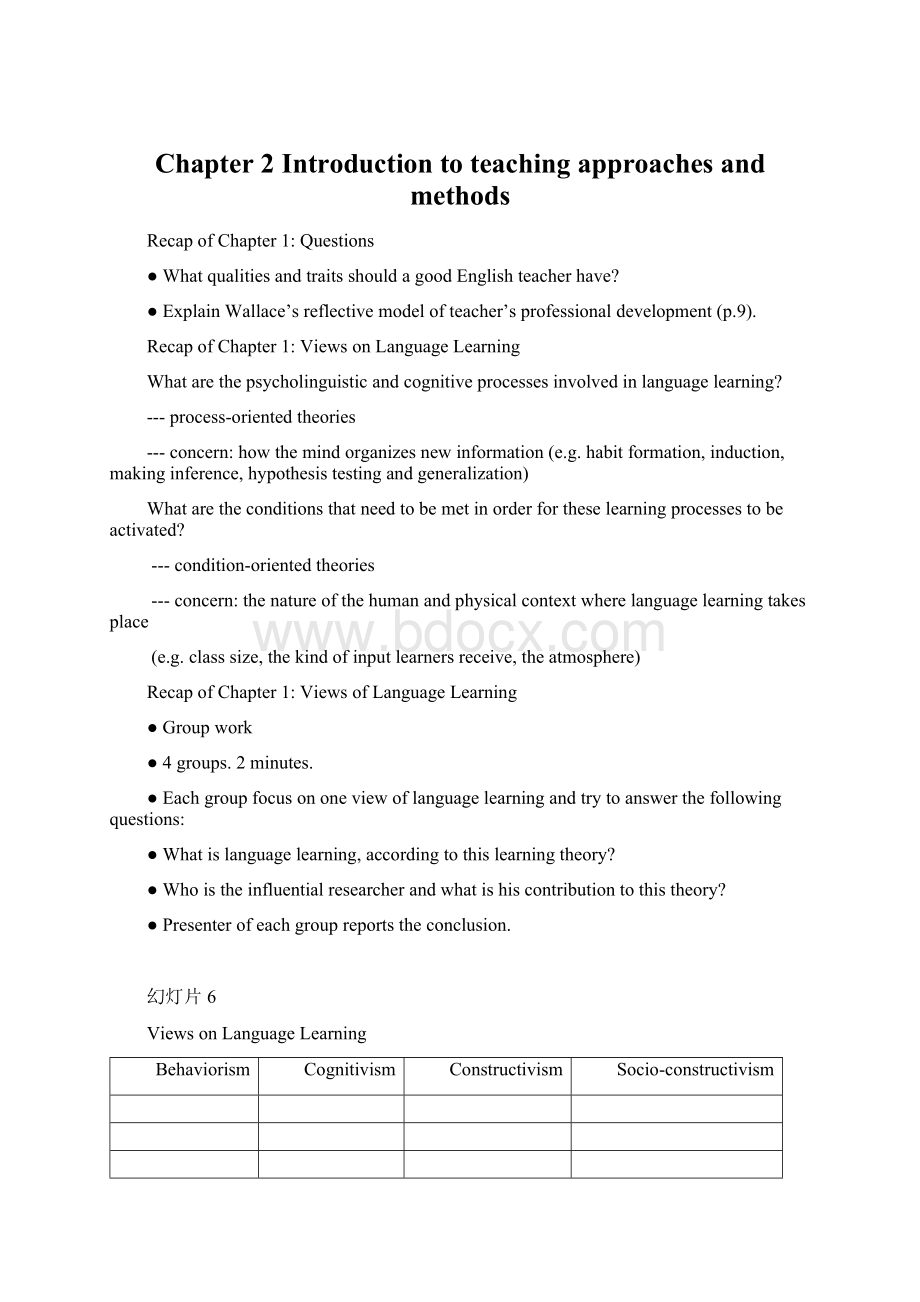Chapter 2 Introduction to teaching approaches and methods.docx
《Chapter 2 Introduction to teaching approaches and methods.docx》由会员分享,可在线阅读,更多相关《Chapter 2 Introduction to teaching approaches and methods.docx(12页珍藏版)》请在冰豆网上搜索。

Chapter2Introductiontoteachingapproachesandmethods
RecapofChapter1:
Questions
●WhatqualitiesandtraitsshouldagoodEnglishteacherhave?
●ExplainWallace’sreflectivemodelofteacher’sprofessionaldevelopment(p.9).
RecapofChapter1:
ViewsonLanguageLearning
Whatarethepsycholinguisticandcognitiveprocessesinvolvedinlanguagelearning?
---process-orientedtheories
---concern:
howthemindorganizesnewinformation(e.g.habitformation,induction,makinginference,hypothesistestingandgeneralization)
Whataretheconditionsthatneedtobemetinorderfortheselearningprocessestobeactivated?
---condition-orientedtheories
---concern:
thenatureofthehumanandphysicalcontextwherelanguagelearningtakesplace
(e.g.classsize,thekindofinputlearnersreceive,theatmosphere)
RecapofChapter1:
ViewsofLanguageLearning
●Groupwork
●4groups.2minutes.
●Eachgroupfocusononeviewoflanguagelearningandtrytoanswerthefollowingquestions:
●Whatislanguagelearning,accordingtothislearningtheory?
●Whoistheinfluentialresearcherandwhatishiscontributiontothistheory?
●Presenterofeachgroupreportstheconclusion.
幻灯片6
ViewsonLanguageLearning
Behaviorism
Cognitivism
Constructivism
Socio-constructivism
幻灯片7
ViewsonLanguageLearning
Behaviorism
Cognitivism
Constructivism
Socio-constructivism
Languageisaformofbehaviorthatcanbelearnedthroughthreestages:
stimulus,responseandreinforcement.
Languageisbothrule-governedandcreative.
Aninnatedeviceinthehumanmind.Thinkratherthansimplyrepeat.
Learningisaprocessinwhichthelearnerconstructsmeaningbasedonhis/herownexperiencesandpriorknowledge.Educationistodevelopthemind.
LearningisthroughdynamicinteractionandengagementwiththetargetlanguageinasocialcontextbasedontheconceptofZoneProximalDevelopmentandscaffolding.
Skinner;basedonthetheoryofconditioning;
theaudio-lingualmethod;structurallinguistics
Chomsky;toallowstudentstoproducetheirownsentencesbasedontheirunderstandingofcertainrules
JohnDewey;learner-centered;teacherasenvironmentdesigner,interactorandfacilitator
Vygotsky;
Teacher’sscaffoldingandmorecapablepeers’supportpromotinglearning
Summary:
20thcentury
●Developmentoflanguagetheories
●structuralfunctionalinteractional
●Developmentoflearningtheories
●behaviorismcognitivismhumanism
Chapter2IntroductiontoTeachingApproachesandMethods
●KeyConcepts(3minutes)
●Majortrendsin20thcenturylanguageteaching(17minutes)
●Alternativeapproachesandmethods:
forself-study(5minutes)
●Currentcommunicativeapproaches(30minutes)
Keyconcepts
●Methodology(方法论)
●(inlanguageteaching)thestudyofthepracticesandproceduresusedinteaching,andtheprinciplesandbeliefsthatunderliethem
●Methodologyincludes
●thestudyofthenatureoflanguageskillsandproceduresforteachingthem
●thestudyofthepreparationoflessonplans,materialsandtextbooksforteachinglanguageskills
●theevaluationandcomparisonoflanguageteachingmethods(e.g.theaudio-lingualmethod)
Keyconcepts
●Languageteachingissometimesdiscussedintermsofthreerelatedaspects:
●Approach(教学理论):
thetheories,philosophyandprinciplesunderlyingaparticularsetofteachingpractices(e.g.communicativeapproach)
●Method(教学方法):
aspecificinstructionaldesignorsystembasedonaparticulartheoryoflanguageandoflanguagelearning(e.g.GTmethod)
●Technique(教学技巧):
classroomactivities(e.g.roleplay,drills,sentencecompletion,etc.)
●Languageteachingsystemalsoinvolvessomeotherfactorsincludingteachingobjectives,syllabus,andtheroleofteachers,studentsandteachingmaterials,etc.
幻灯片12
Majortrendsin20thcenturylanguageteaching
●ABriefHistoryofForeignLanguageTeaching
●Before15thcentury:
Latinasadominantlanguageofeducation,commerce,religion,andgovernmentintheWesternworld
●16th-19thcentury:
●French,ItalianandEnglishV.S.Latin
●Grammar-TranslationMethod/GTMethod(语法翻译法)
●19thcentury:
TheReformMovement(1850s-1860s)
●TheInternationalPhoneticAssociation(1886)
●ThedesignofInternationalPhoneticAlphabet(IPA)
●ThePracticalStudyofLanguages(Sweet,1899)
●DirectMethod
幻灯片13
Majortrendsin20thcenturylanguageteaching
●SituationalLanguageTeaching/OralApproach(情景语言教学法)
●AnapproachtolanguageteachinginTEFL/TESLdevelopedbyBritishappliedlinguistsfromthe1930stothe1960s
●Languagetheory:
Britishstructuralism
●Learningtheory:
behavioristhabit-learningtheory
●Features
●Spokenlanguage>>>Writtenform
●Languageofclassroom:
targetlanguage
●Newlanguagepointsareintroducedandpracticedsituationally.
●Structuralsyllabus:
SelectionofvocabularyandGradationofgrammaritems
●Readingandwritingareintroducedonceasufficientlexicalandgrammaticalbasisisestablished.
●Examples:
textbooksbasedonSLT
●OxfordProgressiveEnglishCourseforAdultLearners
●TheseriesSituationalEnglish
●NewConceptEnglish
●ThePPPlessonmodel(Presentation-Practice-Production)
幻灯片14
Majortrendsin20thcenturylanguageteaching
●TheAudiolingualMethod/Aural-oralMethod(听说法)
●AFLT/SLTmethodprominentinthe1950sand1960s,esp.intheU.S.,whichhasbeenwidelyusedinmanyotherpartsoftheworld.
●AdevelopmentofArmyMethod,whichmainlyaddressedtheneedforamoreintensiveefforttoteachforeignlanguagesinordertopreventAmericansfrombecomingisolatedfromscientificadvancesmadeinothercountries.
●ALMincorporatesstructurallinguisticsandbehavioristpsychology.
●Features
●Listeningandspeaking>>>readingandwriting
●Plannedsituations,gradedmaterials,andsuchtechniquesaspatterndrillsanddialoguememorization
●Almostentirelydroppingtheuseofnaturalsituationsandspontaneousspeech
●Discouraginguseofmothertongueintheclassroom
●Emphasizingintensityofcontactwiththetargetlanguage
●Examples:
variouskindsofdrillsusedinALMclassroom
●Repetition,Inflection,Replacement,Restatement,Completion,Transposition,Expansion,Contraction,Transformation,Integration,Rejoinder,Restoration,etc.
●Problem:
monotonousclassroomandfailureinproducingfluentcommunicatingspeakers
幻灯片15
Alternativeapproachesandmethods(forself-study)
●TotalPhysicalResponse(全身反应法)
●TheSilentWay(沉默法)
●CommunityLanguageLearning(社团语言学习法)
●Suggestopedia(暗示法)
●WholeLanguage(全语言法)
●MultipleIntelligences(多元智能法)
●Competency-BasedLanguageTeaching(能力导向型教学法)
幻灯片16
Alternativeapproachesandmethods(forself-study)
●Assignment
●4groups.Eachmemberofthegroupshouldsearchforinformationabout1-2ofthe7approachesandmethods,andmakeashortsummaryaboutitincludingbackgroundinformation,featuresandoneexampleinteachingpractice.Thesummaryshouldbesenttothegroupleader.
●Thegroupleadershouldmakeahandoutincludingallthesummariesandemailittoallothermembersofthegroupforself-studyandreview.Also,aprintedhandoutissupposedtobehandedin(Before2013-10-2412p.m.,7B121).
●Thehandoutwillbegradedandtheknowledgeaboutthese7approachesandmethodswillpartiallybetestedinQuiz2nextweek.
幻灯片17
Currentcommunicativeapproaches
●CommunicativeLanguageTeaching(交际语言教学法)
●AnapproachtoforeignorsecondlanguageteachingdevelopedparticularlybyBritishappliedlinguistsinthe1980sasareactionawayfromgrammar-basedmethodssuchasSLTandtheALM.
●CLTledtoare-examinationoflanguageteachinggoals,syllabuses,materials,andclassroomactivitiesandhashadamajorimpactonchangesinlanguageteachingworldwide.SomeofitsprincipleshavenbeenincorporatedintoothercommunicativeapproachessuchasTask-basedLanguageTeaching,CooperativeLanguageLearningandContent-basedInstruction.
●Features
●Thegoaloflanguagelearningiscommunicativecompetenceandwhichseekstomakemeaningfulcommunicationandlanguageuseafocusofallclassroomactivities.
幻灯片18
Communicativecompetence
●boththeknowledgeaboutthelanguageandtheknowledgeabouthowtousethelanguageappropriatelyincommunicativesituations
●fivemaincomponentsofcommunicativecompetence(Hedge,2000)(p.18)
●linguisticcompetence,pragmaticcompetence,discoursecompetence,strategiccompetence,andfluency
幻灯片19
TheCommunicativeLanguageTeaching(交际语言教学法)
●PrinciplesofCLT(RichardsandRodgers,1986)
●Communicationprinciple:
Activitiesthatinvolverealcommunicationpromotelearning.
●Authenticmaterialsandinformationgapbetweenlearners
●Taskprinciple:
Activitiesinwhichlanguageisusedforcarryingoutmeaningfultaskspromotelearning.
●Toachievecertainpurposes
●Meaningfulnessprinciple:
Languagethatismeaningfultothelearnersupportsthelearningprocess.
●Relevantandinterestingcontentandactivities
幻灯片20
TheCommunicativeLanguageTeaching(交际语言教学法)
●Sixcriteriaforevaluationofcommunicativeactivities(Ellis,1990)
●communicativepurpose
●communicativedesire
●content,notform
●varietyoflanguage
●noteacherintervention
●nomaterialscontrol
幻灯片21
Currentcommunicativeapproaches
●TheNaturalApproach(自然法)
●AninnovativephilosophyoflanguageteachingproposedbyTracyTerrell(ateacherofSpanishinCalifornia)andStephenKrashen(anAmericanappliedlinguist)intheirbookTheNaturalApproach(1983),basedonKrashen’sinfluentialtheoryofsecondlanguageacquisition.Itemphasizesthecentralroleofcomprehension.
●Anexampleofcommu